The most sophisticated influencer marketing programs in 2025 aren’t choosing between celebrities and micro-influencers—they’re strategically deploying both.
As measurement capabilities improve and audiences fragment, the question isn’t which influencer tier to use, but when each delivers maximum return on investment (ROI) for specific campaign objectives.
A truly successful campaign moves past a single-tier focus and uses a balanced portfolio approach to deploy the right partner at the right time. Understand the authenticity advantage of micro-influencer marketing, but balance this with the mass awareness of macro-influencer and celebrity endorsements.
We’re cutting through the noise and providing you with a complete, actionable blueprint to build a predictable growth engine. By reading this guide, your brand will confidently move past single-tier campaigns to a powerful, multi-faceted strategy.
This guide shows you how to:
- Determine the right creator mix
- Target niche consumers
- Measure true ROI
- Vet partners at scale
- Build a scalable pipeline
Let’s dive into the framework.
The influencer marketing portfolio: A strategic framework
Common misconception: Choosing the right creator tier is about finding a single correct option.
The reality is that it depends entirely on your brand’s campaign objectives. The key lies in constructing a balanced portfolio, much like any other strategic business decision, where diversifying your investments is crucial.
To succeed in influencer marketing in 2025:
- Build a balanced creator portfolio
- Align the creator type directly with your campaign objectives
- Understand each creator tier’s unique benefits, from celebrities to micro-influencers
- Deploy creators strategically for the highest ROI, depending on your objectives
| Campaign objective | Use case | Industry examples | Recommended influencer mix |
| Mass awareness | Broad brand visibility: Reach a huge, general audience quicklyNew market entryProduct launch | Consumer packaged goods Automotive General tech | Primary: Celebrity/mega (1–3 partnerships) Secondary: Macro (5–10 partnerships) Support: Micro (20–50 for proof points) |
| Niche market penetration | Community building and trust: Establish credibility within a specific, focused groupCategory creation | B2BClean beauty FintechSpecialty gaming | Primary: Micro (50–200 partnerships) Secondary: Nano (500+ organic advocates) Support: Macro (2–5 for credibility) |
| Conversion optimization | Direct sales and attribution: Drive measurable traffic and immediate purchases | E-commerceDirect to consumer (DTC)Subscription services | Primary: Micro (100+ partnerships) Secondary: Affiliate micro-influencers Support: Macro for seasonal peaks |
| Brand repositioning | Cultural association and credibility: Change public perception RelaunchCrisis recovery | HealthcareLuxury goodsFinancial Services | Primary: Celebrity (1–2 trusted voices) Secondary: Industry experts (5–10) Support: Employee advocates + micro |
When micro-influencers win
For conversion-focused campaigns targeting niche audiences, micro-influencers (with 15,000-75,000 followers) consistently outperform on efficiency metrics. This is due to the fundamental power of authenticity and relatability.
Often operating within niche communities, these creators build a community around shared passions:
- Clean beauty
- Plant-based cooking
- Performance running
- Sustainable living
@organicoraclemail is a clean beauty creator with 35,000 Instagram followers. She’s built an audience by focusing on sustainable skincare and natural products.
Instead of chasing mass appeal, she speaks directly to a highly engaged group of people who trust her recommendations because they see her as an authentic peer rather than a distant celebrity.
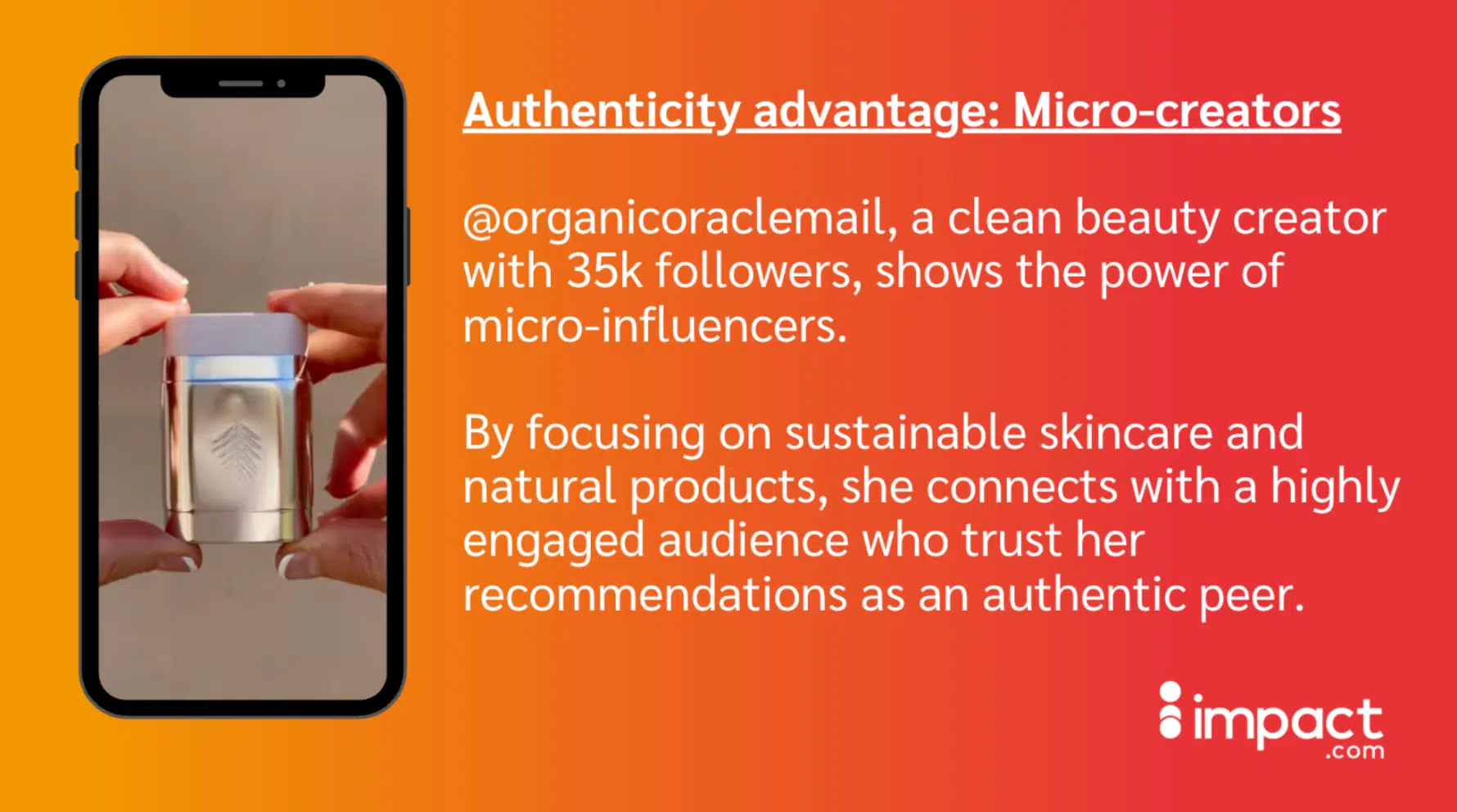
Micro-influencers appear as relatable peers. Audiences see them as “one of us,” and that authenticity translates into influence that drives purchases.
In saturated social media feeds, trust is the new currency. Micro-influencers are the go-to choice for many brands. Why? Their recommendations resonate more deeply, spark meaningful engagement, and create a ripple effect of credibility.
| Micro-influencer metrics | |
|---|---|
| Cost | Affordable, with an average cost per sponsored post of $2,000-$8,000, depending on the social platform. |
| Engagement rate | Higher than average engagement rates, starting at one percent. |
| Conversion rate | 20 percent higher conversion rates than larger creators. |
| Audience trust | High trust levels as recommendations feel genuine and peer-to-peer. |
| Audience targeting | Highly specific, niche-focused audiences. |
| ROI | High ROI, earning an average of $5.78 for every $1 spent |
| When to use | For building genuine community, driving conversions, generating user-generated content (UGC), and targeting specific niches. |
The strategic case for celebrity and macro-influencer partnerships
Macro-influencers (with 250,000 to one million followers) and celebrities (with more than one million followers) play a crucial and specialized role in a well-balanced influencer portfolio. They go beyond niche targeting and conversions.
Mass market reach efficiency
When Lays partners with Lionel Messi, they’re not optimizing for engagement rate—they’re buying access to 500M+ followers across markets where local micro-discovery would take years. The cost per mille (CPM) calculation looks different at that scale.
Aspirational brand positioning
Luxury brands like Omega aren’t measuring click-through rates when they partner with Daniel Craig. They’re purchasing cultural association and prestige signaling that micro-influencers cannot provide, regardless of authenticity scores.
Overcoming skepticism
In categories like healthcare, finance, and insurance, celebrity credibility can overcome skepticism that even authentic micro-influencers face due to category-level trust issues.
| Macro-influencer and celebrity metrics | ||
|---|---|---|
| Macro-influencers | Celebrities | |
| Cost | Moderate to high. $20,000-$49,000 per post on major platforms like Instagram or YouTube. | Very high. Rates begin at $45,000 and can climb into the hundreds of thousands for full campaigns and extensive usage rights. |
| Engagement rate | Moderate to low. Typically ranges from 1%–3%. | Often below 1%. |
| Conversion rate | Moderate to Low. Lower conversion effectiveness compared to Micro due to broader audience. | Often lower return on sales despite massive reach. |
| Audience trust | Moderate. Content is perceived as professional but less personal and more transactional. | Lower trust due to obvious commercial perception. |
| Audience targeting | Broad. Offers larger reach but with lower targeting precision. | Mass-market. Designed to reach a broad, general audience. |
| ROI | Moderate. Lower cost-effectiveness per engagement than Micro. | Lower ROI due to high cost and lower engagement. |
| When to use | For instant, large-scale brand awareness, streamlined professional campaign assets, and major product announcements. | For mass awareness campaigns, aspirational brand positioning (e.g., luxury), and establishing credibility in regulated industries (e.g., healthcare). |
How to calculate influencer ROI: A step-by-step framework
It’s one thing to believe in the power of an influencer portfolio; it’s another to prove it. Here’s the solution: use ROI as your benchmark.
When you calculate ROI, you can clearly demonstrate its effectiveness to stakeholders and secure future budgets.
Let’s dive into a clear, step-by-step framework to measure ROI with confidence.
Pre-campaign setup: Setting trackable goals
The foundation of ROI starts long before a single post goes live. To measure success, you first need to define what success looks like.
Ask yourself: What’s the primary outcome you want from this campaign?
Common campaign goals include:
- Brand awareness: Measured by impressions, reach, or follower growth
- Conversions: Tracked through clicks, promo codes, or sales generated
- UGC: Evaluated by the volume and quality of creator content
Each goal points to a different set of metrics. For instance, if your aim is conversions, sales attributed to influencer content will be your North Star.
If awareness is the priority, engagement rates and reach matter more.
By aligning goals with the right metrics up front, you create a clear path for measuring ROI, and a stronger case for scaling your program.
During campaign: Key metrics to monitor
Tracking performance in real time gives you the agility to optimize mid-campaign and ensure the budget isn’t wasted. The right metrics depend on your goals, but these benchmarks provide a strong foundation:
- Reach and impressions: This metric indicates the number of people who saw the content, serving as a key indicator of brand awareness and campaign visibility.
- Engagement rate: High engagement (likes, comments, shares, and saves) indicates strong audience resonance, trust, and authenticity.
- Link traffic and click-through rate (CTR): Measures the number of users who clicked through to your site, helping you gauge interest beyond social engagement.
- Brand mentions: A useful proxy for community buzz and growth, especially when paired with sentiment analysis.
- Conversion rate: The percentage of users who completed a desired action (purchase, signup, download) after engaging with influencer content.
Monitoring these metrics while campaigns are live allows you to double down on what’s working and pivot quickly if certain tactics underperform.
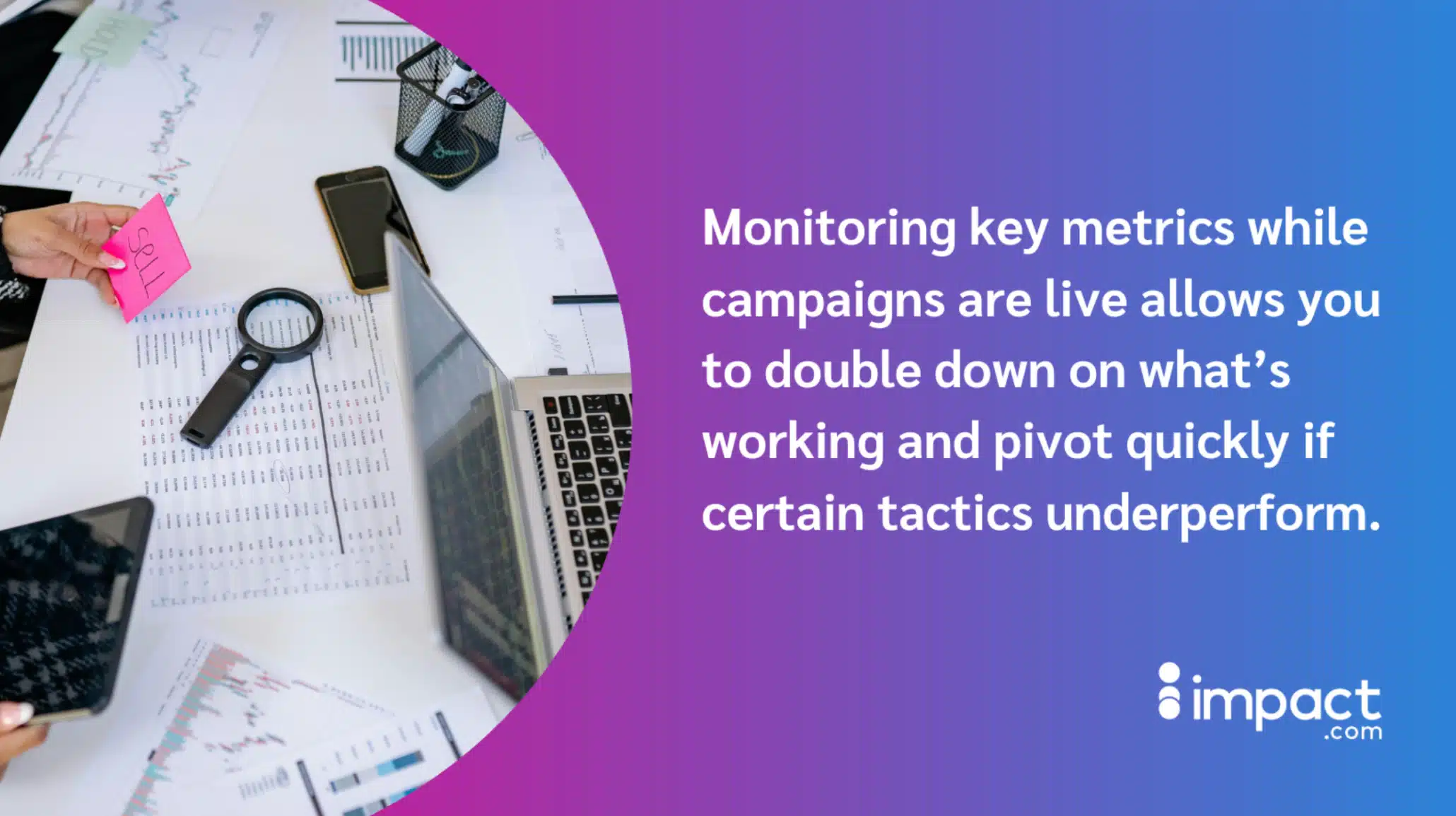
Formula 1: Cost per engagement (CPE) — Best for awareness campaigns
What it measures: The cost of each audience interaction (likes, comments, shares, saves)
When to use it: Brand awareness campaigns, top-of-funnel initiatives, or when building community engagement
The formula:
CPE = Total campaign cost ÷ Total engagements
Example:
- Campaign cost: $2,000
- Total engagements: 5,000 (likes, comments, shares, saves)
- CPE = $2,000 ÷ 5,000 = $0.40 per engagement
Why CPE matters: While engagement doesn’t directly equal sales, it indicates content resonance and builds the brand awareness necessary for future conversions.
Formula 2: Cost per acquisition (CPA) — Best for conversion campaigns
What it measures: The cost to acquire each new customer through influencer content
When to use it: E-commerce campaigns, lead generation, app installs, or any conversion-focused initiative
The formula:
CPA = Total campaign cost ÷ Total conversions
Example:
- Campaign cost: $3,000
- New customers acquired: 75
- CPA = $3,000 ÷ 75 = $40 per customer
Strategic insight:
Compare your influencer CPA against other channels:
- If your paid search CPA is $65 and influencer CPA is $40, you’ve found a more efficient channel
- If influencer CPA exceeds other channels, evaluate content quality or creator alignment
Formula 3: Overall ROI — The complete profitability picture
What it measures: The total return on your influencer marketing investment as a percentage
When to use it: Post-campaign analysis, budget justification, or comparing influencer marketing ROI against other marketing channels
The formula:
ROI = [(Total revenue – Total campaign costs) ÷ Total campaign costs] × 100
Example:
- Campaign cost: $5,000
- Revenue generated: $20,000
- ROI = [($20,000 – $5,000) ÷ $5,000] × 100 = 300% ROI
Translation: For every $1 spent, you earned $3 in profit.
The LTV multiplier: Why lifetime value changes everything
Most marketers calculate ROI using only initial purchase value. This understates the true impact of influencer marketing.
Why LTV matters for influencer campaigns:
Micro-influencer audiences typically deliver higher-quality customers who:
- Make repeat purchases at 1.5-2x the rate of paid ad customers
- Have 20-30% higher average order values over time
- Demonstrate stronger brand loyalty and lower churn rates
Case study: HostZealot’s 8x ROI through LTV calculation
Vladimir Lebedenko, Chief Marketing Officer at HostZealot, shares how LTV transformed their influencer ROI measurement:
“Let’s say we invest $1,500 for three sponsored posts and those posts generate 100 trial sign-ups. Twenty sign-ups convert into paying customers with an LTV of $600. That makes the total revenue $12,000.
Using the ROI formula: [($12,000 – $1,500) ÷ $1,500] × 100 = 700% ROI
That’s roughly an 8x return compared to what we’d get from broader paid social media campaigns, which typically deliver 2-3x ROI for us.”
The takeaway: When evaluating influencer partnerships, calculate both:
- Initial ROI (first purchase only) — Shows immediate performance
- 12-month ROI (including repeat purchases) — Shows true channel value
This dual measurement reveals which influencers drive one-time buyers versus loyal customers.
How to build an influencer portfolio spreadsheet
To simplify this process, create a spreadsheet that includes columns for each metric along with your campaign costs. This will allow you to plug in the numbers and automatically calculate your ROI.
Consider the following metrics for each column:
- Reach
- Shares
- Engagement
- Conversions
- Total campaign cost
- Total sales
- Customer LTV
Depending on your goals, your worksheet could look something like this:
| Partner name | Follower size | Campaign name | Reach | Engagement | Conversions | Shares | Total campaign cost | Total sales |
| Jane Doe | Micro | Summer Collection | 10k | 4% | 76 | 350 | $2,000 | $8,300 |
| John Smith | Macro | Q4 brand boost | 450k | 1.8% | 120 | 900 | $25,000 | $50,000 |
| Reality TV star | Celebrity | Seasonal campaign kickoff | 5M | 0.5% | 450 | 5,000 | $100,000 | $320,000 |
The complete guide to finding and vetting authentic influencers of any size
Even the most well-planned campaign will fail if you partner with the wrong creators. Successful influencer marketing stems from authentic alignment.
You should find voices your audience already trusts. That means going beyond follower counts to evaluate their:
- Reach
- Audience engagement
- Brand alignment
Next, we’ll go through a step-by-step process to discover and vet authentic influencers who can deliver meaningful results.
Where to find aligned creators
Finding the right creators shouldn’t feel like guesswork. With the right mix of tools and organic discovery, you can build a pool of creators who are authentic and aligned with your brand.
- Platforms and tools: Platforms like impact.com’s marketplace help you find vetted creators by niche, engagement, and demographics.
- Browser extensions: Chrome extensions make sourcing even easier by pulling up real-time creator metrics without leaving your current workflow.
- Organic discovery: Search social media to find relevant hashtags, industry conversations, and observe who your followers engage with.
- Branded hashtags: Monitor your own branded hashtags to spot customers and fans already creating content about your products.
- Social Listening tools: Find potential partners who use and promote your products or brand with Social Listening features.
By combining tech-driven searches with organic community insights, you’ll discover influencers who feel like a natural extension of your brand story.
Red flag checklist for inflated creator accounts
Not every profile with a decent following is genuine.
To avoid wasting budget on inauthentic accounts, keep an eye out for these red flags:
- Unusual follower-to-following ratio
- Sudden follower spikes
- Generic comments
- Low or unrealistic engagement rates
- Inconsistent posting

Unusual follower-to-following ratio
A 1:1 ratio often signals a “follow-for-follow” tactic. Authentic creators typically have a much higher follower count compared to the accounts they follow.
Sudden follower spikes
Unexplained jumps in followers (more than 20 percent growth in 30 days without a viral moment) can indicate purchased followers.
Generic comments
Scroll through the comments section. If you see mostly one-word responses or emojis from suspicious accounts, that’s a sign of fake engagement. Look for real conversations with thoughtful feedback, questions, and interactions.
Low or unrealistic engagement rates
Luca Dal Zotto, Co-Founder of Rent a Mac, explains that engagement rates under two percent for smaller size creators suggest an inactive audience. He adds that anything consistently above eight percent is likely inflated unless the content recently went viral.
Inconsistent posting
You can also evaluate the consistency of a creator’s content over a six-month period. Genuine creators are consistent with their posting schedule and adhere to their niche 80 percent of the time.
Engagement quality assessment
A strong engagement rate is a good starting point, but numbers alone don’t tell the whole story. To evaluate whether an influencer’s community is truly invested, look at the quality of interactions:
- Conversation depth: Do followers ask questions, share experiences, or tag friends? Meaningful exchanges signal trust and influence.
- Comment variety: Genuine engagement goes beyond “love this!” or fire emojis. Look for thoughtful feedback and specific reactions to the content.
- Audience consistency: Authentic creators build a loyal community that regularly shows up, not just one-off spikes in likes or comments.
Brand alignment evaluation
The right partners aren’t always defined by audience size or engagement rates.
They’re the ones whose content naturally aligns with your brand’s story and values.
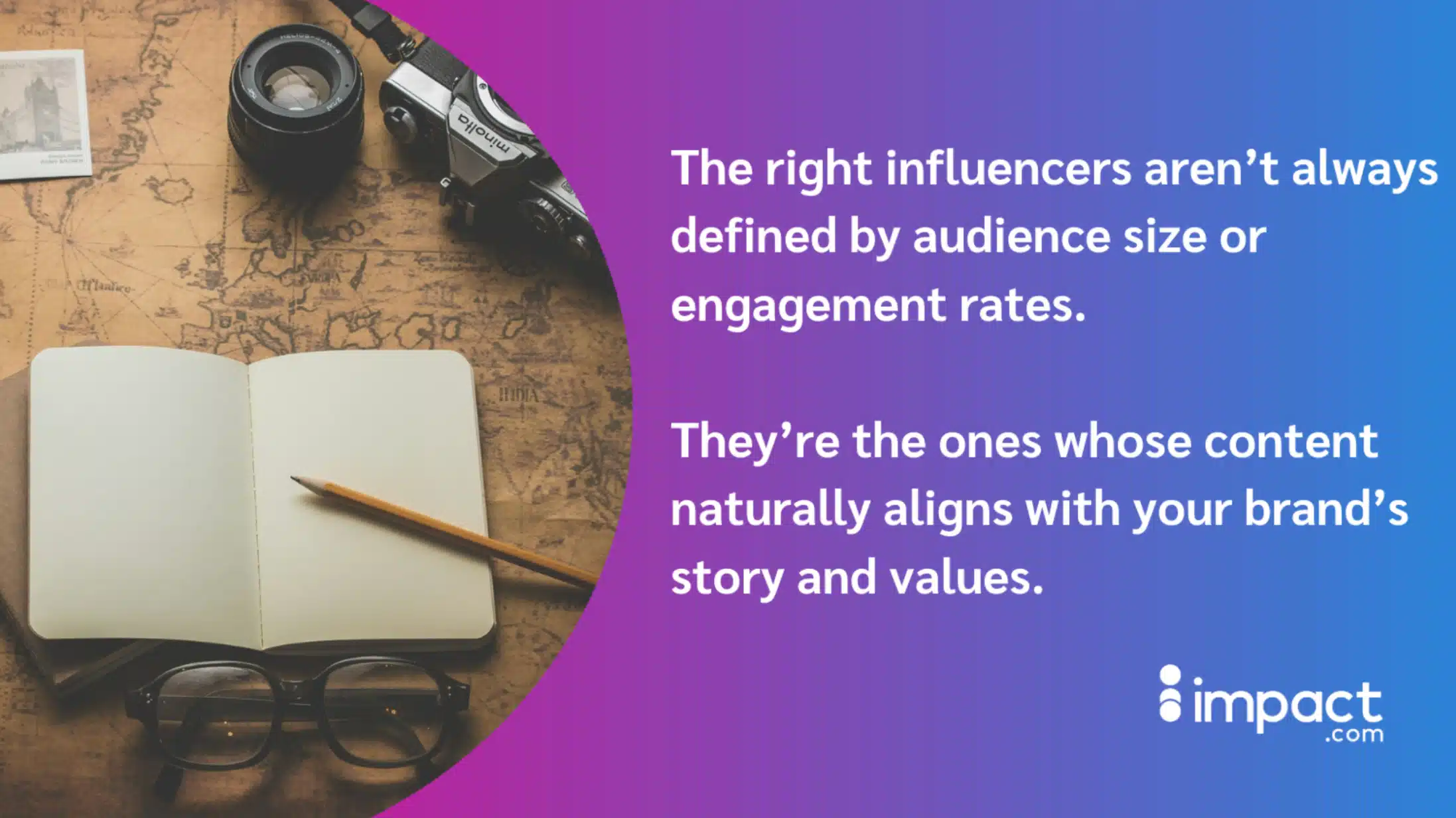
Don’t force the connection
Real partnerships come from genuine alignment, not forced connections. Zoe Rice, Marketing Manager at 3 Men Movers, looks for creators who already share stories that naturally align with moving transitions.
Rice highlights a partnership with a pet-focused micro-influencer who documented the stress of moving with dogs. The influencer wasn’t pitching services at all. She shared a relatable experience that her followers cared about.
That organic alignment made the collaboration a natural success.
The same test applies when you start to evaluate potential partners:
- Do their posts already reflect your brand’s values, even without sponsorship?
- Does their audience respond with genuine curiosity or relevant questions?
- Is there evidence of a lived experience that connects to your product or service?
If the answer is yes, you’ve found the kind of creator whose authenticity will translate into impact.
Seek honest content creators
It’s easy for influencers to focus only on the positives. But creators who share both wins and challenges often build deeper trust with their audiences.
Leigh McKenzie, Community Advocate at Traffic Think Tank, explains that influencers who are honest about the ups and downs of their work often resonate more, as their audience views them as trustworthy and authentic.
“We worked with an influencer who didn’t have a lot of followers but was known for being honest about both SEO campaign successes and failures. It was clear that people in our community trusted her because she didn’t leave out the hard parts,” McKenzie explains. “We got more qualified signups from that effort than from bigger, better-known influencers ever did.”
Honesty creates credibility, and credibility drives conversions.
Adrienne Folse, Founder of Design the Planet, suggests asking yourself one key question before partnering: “Were they sharing relevant content long before sponsorships were on the table?”
Reviewing a creator’s content history helps you gauge whether their lifestyle and values truly align with your brand. If they were posting about the topic before money entered the picture, it’s a strong signal of authentic passion.
The brand trust contract
Authenticity is a two-way street.
For a partnership to truly resonate, your brand must honor the creator’s voice and relationship with their audience. This means setting up a “Trust contract” where your brand agrees to:
- Timely product delivery: Provide the product or service well in advance for the creator to genuinely use and form an opinion.
- Creative freedom: Issue a flexible creative brief with talking points, not a script. The creator’s voice is their primary asset.
- Honest feedback: Allow the creator to discuss the real experience (including minor challenges), which surprisingly builds more trust than pure, uncritical praise.
Creator authenticity cheat sheet
Not sure if a creator is truly authentic? McKenzie suggests running through this quick checklist:
- Do they share wins and struggles? Real creators talk openly about challenges, not just highlight reels.
- Are their followers genuinely engaging? Look for thoughtful questions and conversations, not just one-word comments or emojis.
- Do they blend personal stories with professional tips? A mix of both signals a creator who connects on a human level.
- Are they selective about partnerships? Authentic influencers don’t promote everything. They choose brands that align with their values.
If the answer is “yes” to most of these, you’ve likely found a creator whose authenticity will resonate with your audience.
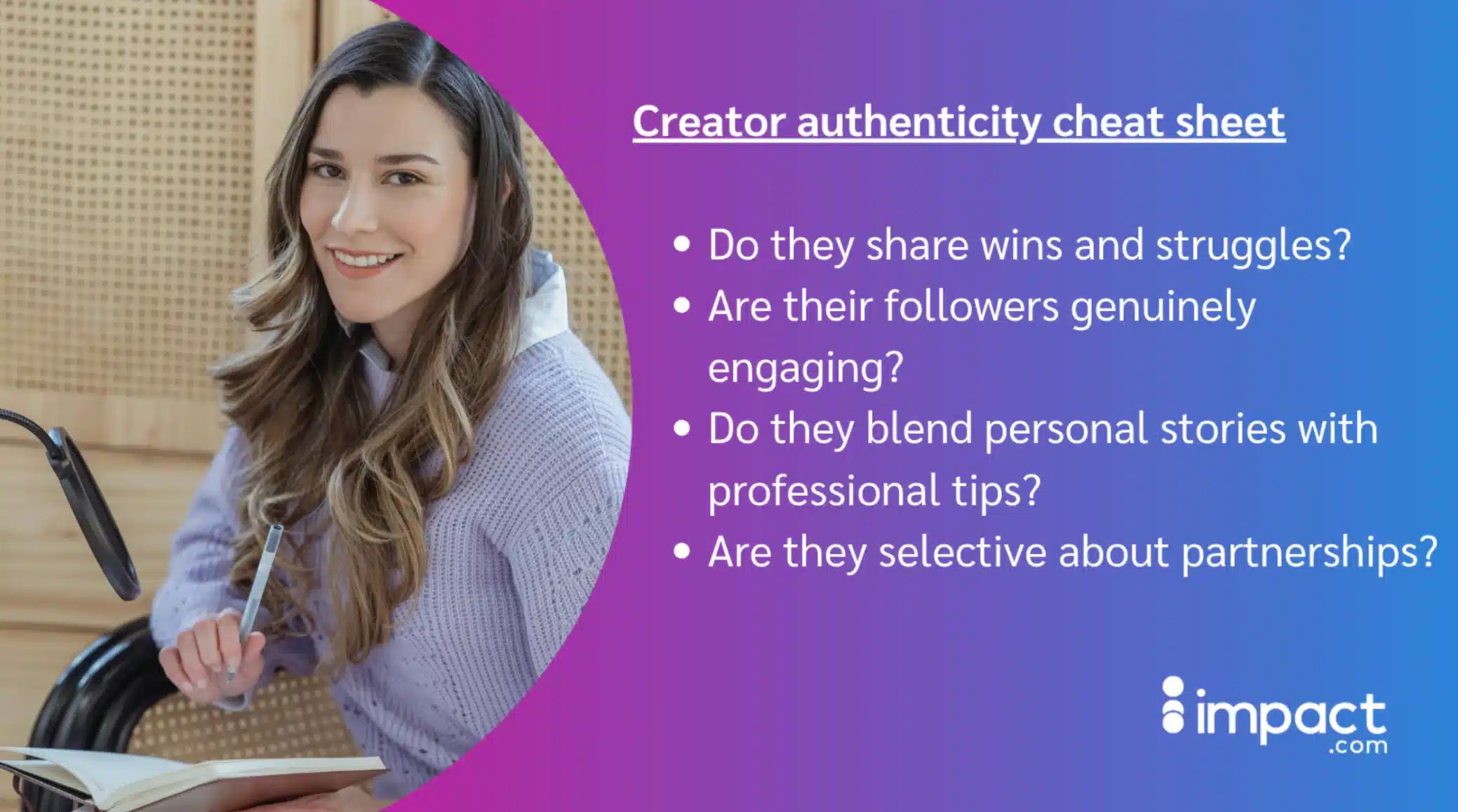
How to reach out: Building a knockout outreach template
Once you’ve identified the right micro-influencer, the next step is making a strong first impression. A generic “let’s collab” won’t cut it.
Your outreach should feel personal, thoughtful, and respectful of their creative process.
Here’s a simple template you can adapt:
Subject line: [Your Brand Name] × [Influencer Name] Partnership Opportunity
Body:
- Start with a compliment. Reference a specific post, video, or story you loved to show you’ve done your homework.
- Explain the fit. Share why their aesthetic, tone, or personal brand aligns with your company’s values.
- Offer creative freedom. Provide a brief outline of your key messaging, but leave room for them to use their own voice and format.
- Close with a clear call to action (CTA). Suggest scheduling a quick call or ask them to share their media kit.
A little personalization goes a long way. Thoughtful outreach shows creators you value their work and sets the stage for an authentic partnership.
Creator campaign budget framework: How much to spend (and where)
A strategic budget is key to a successful influencer marketing campaign.
Here’s how to allocate your funds effectively across all creator tiers in your portfolio.
Industry-specific budget guidelines
Instead of sticking to a one-size-fits-all budget, tailor your spend to your industry and campaign goals.
A flexible approach ensures you’re investing where it matters most.
Here are four key factors to consider when allocating funds:
- Production value
- Influencer expertise
- Content authenticity
- Unique deliverables

Production value
Luxury goods, high-end fashion, and automotive brands often need polished, professional content to match their premium image. Expect higher production costs for these verticals.
Influencer expertise
In industries such as beauty, technology, or fitness, creators often need to produce tutorials, product demonstrations, or in-depth reviews. These formats often require larger budgets.
Content authenticity
Food, beverage, and home goods brands benefit from relatable, real-life content. These campaigns can be more cost-effective since the value stems from trust and relatability, rather than high-end visuals.
Unique deliverables
Travel, hospitality, and gaming campaigns may include extra expenses such as travel, accommodations, or specialized content like livestreams or multi-part series.
Budgeting summary: Your budget should match both your campaign goals and the type of content needed to achieve them. Thoughtful allocation ensures every dollar works harder toward delivering ROI.
Amplifying success: The paid boost lever
You know the beauty of content creators: micro-influencers generate authenticity, while celebrities generate buzz that no one else can replicate.
But to truly scale their success, budget for paid amplification.
- Implement the paid boost strategy: Allocate 10-20 percent of your campaign budget to media spend, boosting the top 5-10 percent of content created.
- Achieve targeted reach: Leverage proven, high-converting content within a niche by boosting it to a broader, targeted audience on your own channels.
This strategy effectively turns micro-reach into macro-reach, combining the creator’s authenticity with the precision of performance marketing.
Long-term vs one-off campaign allocation
How you allocate your budget depends on the type of campaign you’re running. Both one-off and long-term partnerships can deliver results, but the value they create looks very different.
| One-off vs long-term influencer strategy comparison | ||
|---|---|---|
| Feature | One-off campaigns | Long-term partnerships (creators/ambassadors/affiliates) |
| Primary goal | Drive immediate action and create buzz. | Build genuine trust and customer loyalty. |
| Best for | Product launches, seasonal pushes, or limited-time promotions. | Sustained influence, continuous ROI, and predictable performance. |
| Budget and costs | A set, one-time budget is typically required. | Often saves money and is more cost-effective to sustain. More than 70 percent of influencers are willing to offer discounts for long-term deals. |
| Content authenticity | Content is created for the specific push. | Partners who know and trust your brand weave it naturally into their content, which resonates more with their audience. |
| Key metrics | Impressions, immediate sales, and CTR. | LTV, more predictable performance, and a continuous stream of UGC. |
| Relationship | Transactional; high churn in finding and onboarding new partners. | Prioritizes relationships over transactions; easier recruitment and management process over time. |
Hidden costs to factor in
When planning your budget, it’s easy to focus only on fees paid to influencers. But there are often additional costs that can impact your ROI if you don’t account for them upfront:
- Product or service costs: Factor in the expense of the items or services you’re sending to creators as part of the collaboration.
- Time-intensive management: Coordinating with multiple micro-influencers takes time, from negotiating contracts to reviewing and managing content.
- Content rights: If you want to repurpose influencer content across your own channels, budget for the licensing fees that may apply.
Building these hidden costs into your plan ensures your campaign budget reflects the true investment and avoids surprises down the road.
The authenticity equation: A formula for modern marketers
Authenticity isn’t a buzzword. It’s a tangible concept you can measure. When working with micro-influencers, you can evaluate authenticity using a simple framework:
Authenticity = (R + E + N) × A
Here’s what each variable represents:
Relatability (R)
How much the audience can identify with the influencer’s story. For example, a mom influencer sharing how a product saves her time with her kids instantly connects with other parents.
Engagement (E)
Genuine interactions such as comments, shares, and saves. Micro-influencers often excel in this area, sparking genuine conversations with their communities.
Niche expertise (N)
Authority in a specific area that boosts content credibility. A macro-creator, such as a certified nutritionist, reviewing protein powders offers more trust than a general fitness influencer.
Affinity (A)
The emotional connection between influencer, audience, and your brand. When an influencer has a genuine connection to your brand, the message feels natural and persuasive.
If one piece is missing, the whole equation breaks down. For example, a high-engagement post about a brand with no true affinity will ring hollow, and audiences can spot it instantly.
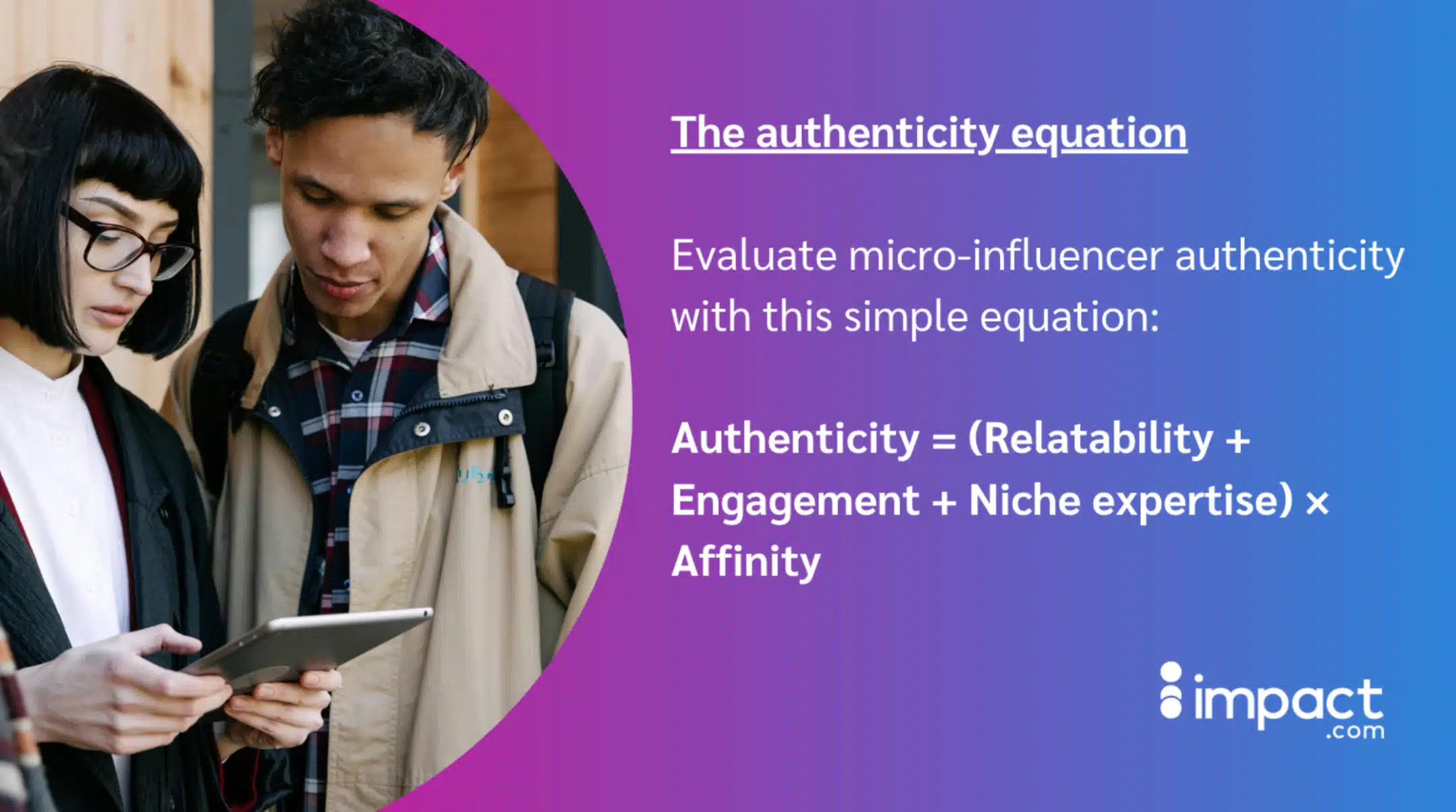
Use the table below as a guide to score each variable:
| Creator authenticity scoring matrix (1-5 scale) | ||
|---|---|---|
| Variable | Score | Description and actionable criteria |
| Relatability [R] | 1 (Low) | Creator’s content is heavily filtered or highly aspirational, lacking vulnerability or everyday scenarios. Audience comments focus on distance/admiration, not connection. |
| 3 (Medium) | Creator shares some personal stories, but the content is inconsistent. They connect with a broad audience but not a deep niche. | |
| 5 (High) | Creator consistently shares wins and struggles, making them seem like a peer. Content focuses on experiences their audience can directly relate to. | |
| Engagement (E) | 1 (Low) | Engagement rate is below 2% for smaller creators. Comments are generic (one-word responses, emojis). |
| 3 (Medium) | Engagement rate is average (2-4%). There are some meaningful exchanges, but the creator rarely responds to followers. | |
| 5 (High) | Engagement rate is strong (4%+) and, more importantly, includes meaningful exchanges. Followers ask thoughtful questions, tag friends, or share experiences. | |
| Niche expertise (N) | 1 (Low) | The creator is a generalist, and their content niche is inconsistent or changes frequently. They lack professional authority on the topic. |
| 3 (Medium) | Creator is clearly interested in the niche but has no specific certifications, unique skills, or depth of knowledge. | |
| 5 (High) | Creator has authority in a specific area (e.g., a certified nutritionist for protein powders) and adheres to their niche 80% of the time. Content provides unique value and specific tips. | |
| Affinity (A) | 1 (Low) | No content about your brand/category before sponsorship. The partnership feels forced. The creator promotes many competing brands. |
| 3 (Medium) | The creator has posted about similar products before, but there’s no evidence of them being a true fan or long-term user. | |
| 5 (High) | The creator shared relevant content long before sponsorships were considered. Their content naturally aligns with your brand’s story and values. | |
Building a long-term creator pipeline: Your action plan
Scaling your influencer marketing portfolio isn’t about chasing one-off wins. It’s about building a pipeline of authentic, long-term relationships that deliver consistent ROI.
Follow these four steps to build your strongest influencer marketing portfolio yet:
- Focus on the “why” when recruiting creators
- Prioritize relationships over transactions
- Measure beyond follower count
- Empower the creator
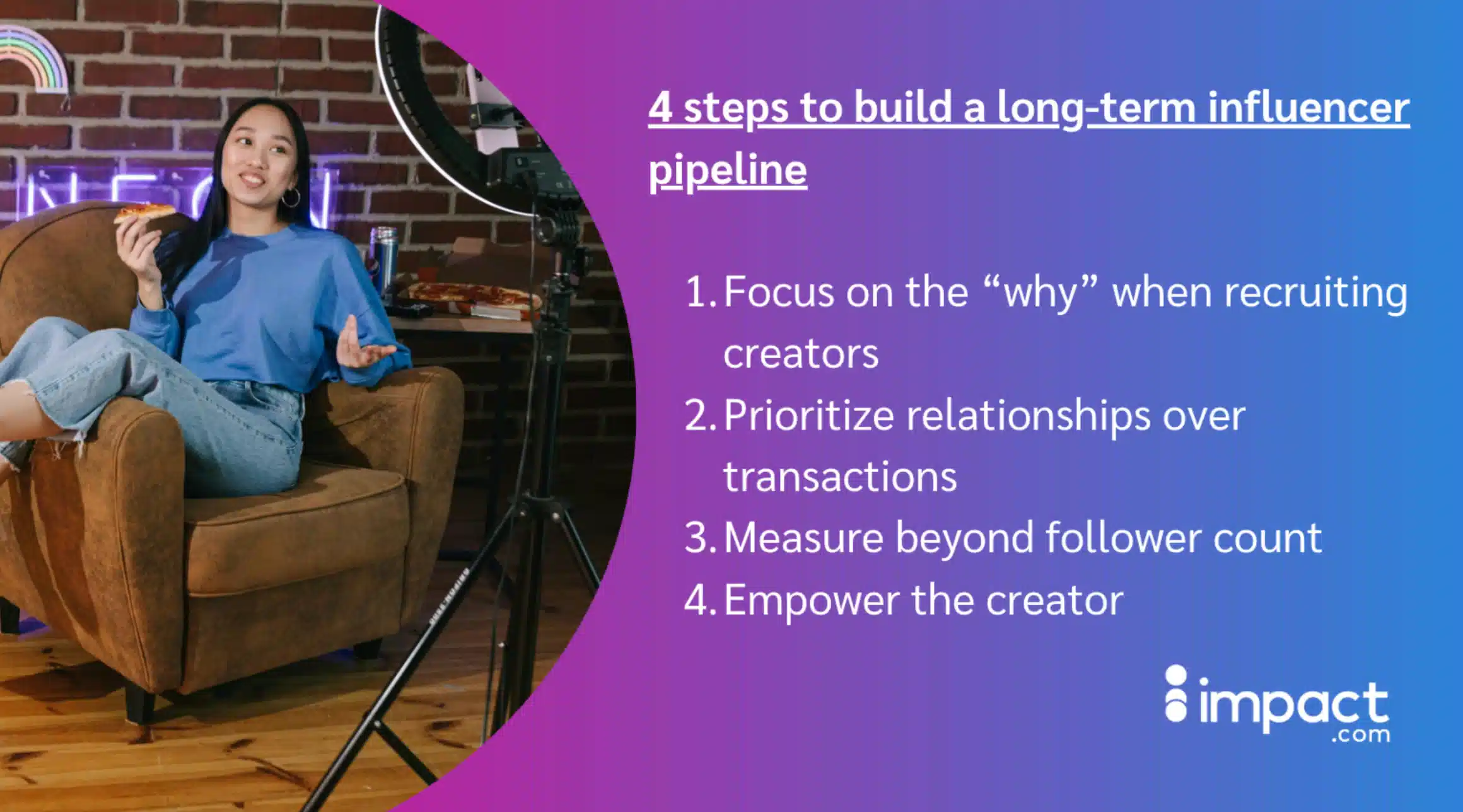
Step 1: Focus on the “why” when recruiting creators
Look for influencers who already share your brand’s values. Their tone and content style should feel like a natural fit.
A strong indicator of authenticity is when a creator’s existing content already mirrors the values of the brands they partner with.
@project.catherine is a micro-influencer specializing in sustainable fashion and ethical living. Long before collaborating with brands, her feed featured:
- Thrifted outfits
- Slow fashion tips
- Commentary on conscious consumerism
When sustainable fashion brands work with her, the partnership feels natural to audiences because it builds on content she was already sharing.
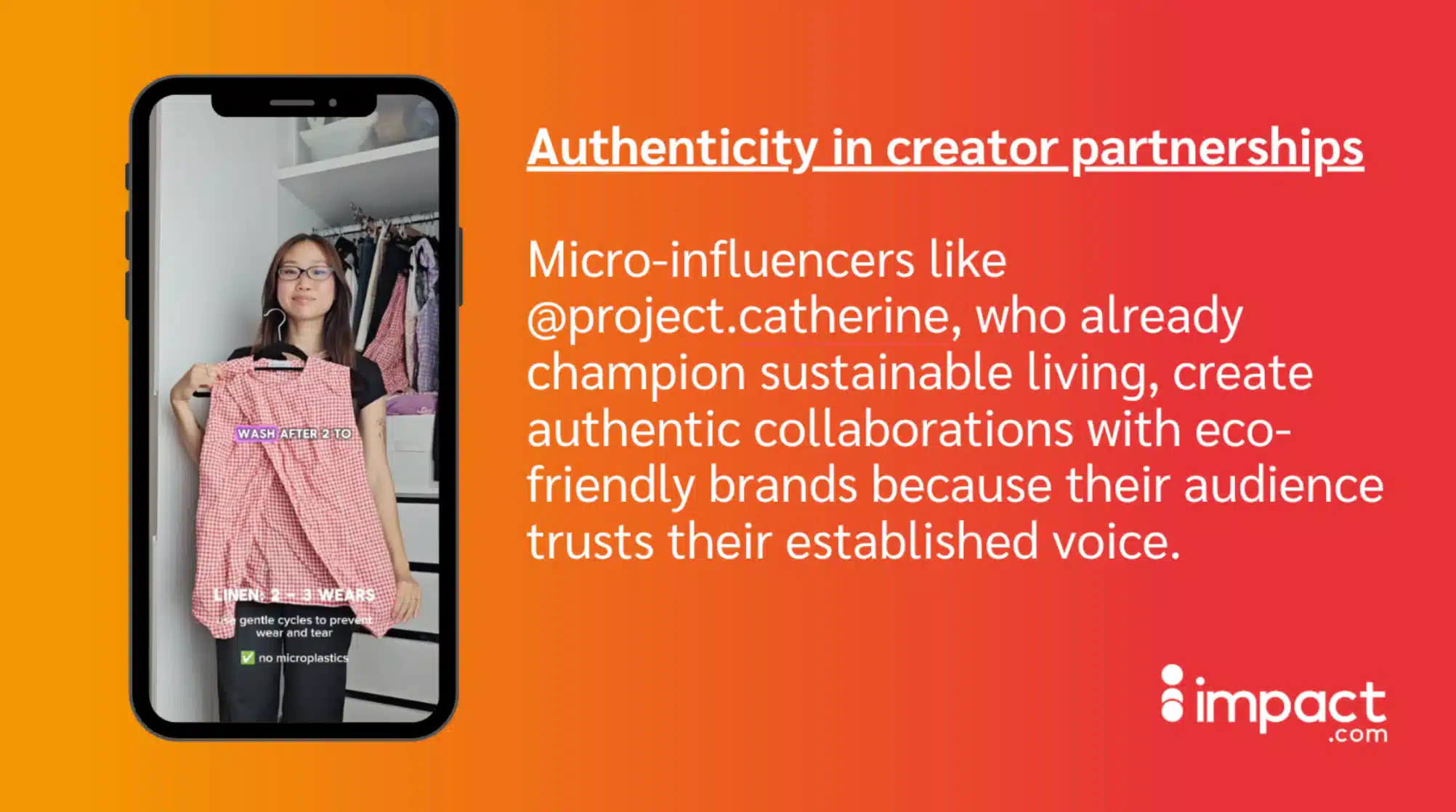
Pro tip: Before reaching out, ask yourself: Does this person’s content align with my brand values, even without a partnership?
Step 2: Prioritize relationships over transactions
One-off posts generate quick hits, but long-term relationships save money and create more authentic content.
Olivia Savage, Senior Marketing Strategist at impact.com, suggests open communication with the creator to find out what they charge for specific deliverables.
“When running creator campaigns at impact.com, there have been times when we’ve offered a small flat fee and still seen strong interest,” Savage says. “But some creators come back and say, ‘I can’t do an Instagram Reel at that rate. My price for Reels is higher. I could do a Story instead.”
Pro tip: If Instagram Reels are pricier, negotiate a package deal that includes Stories or carousels. Remember that investing early in a creator’s journey often yields higher LTV for your brand as their influence grows.
Step 3: Measure beyond follower count
Vanity metrics don’t tell the whole story. To understand real impact, track the metrics that matter:
- Link clicks: A clear sign of interest beyond the platform.
- Engagement rates: Comments, saves, and shares that show meaningful interaction.
- Brand mentions and sentiment: Gauge not only how often your brand comes up, but the tone of the conversation.
- Conversion rates: The ultimate measure of ROI.
- Audience quality: Make sure the influencer’s reach aligns with your target demographic.
Pro tip: Focus on metrics that matter. See how your traffic, engagement rates, brand mentions, and conversion rates contribute to your overall success.
Step 4: Empower the creator
Creators value being part of the creative process.
Giving them freedom ensures content feels authentic and resonates with their audience. Most creators emphasize the importance of strong working relationships and creative freedom, particularly when evaluating opportunities for long-term partnerships with brands.
Pro tip: Share a flexible creative brief with key talking points instead of a rigid script. This lets influencers stay true to their own voice while hitting your brand’s priorities.
Real-world example: Nike’s influencer portfolio strategy
Nike has mastered the influencer portfolio approach. The iconic sports brand uses different tiers to target the entire consumer journey, from mass aspiration to niche conversion.
Instead of relying on a single channel or creator type, Nike orchestrates a layered strategy. This strategy helps the brand maintain its global dominance and local relevance.
Tier breakdown: Who does what in the Nike ecosystem
Nike’s influencer strategy uses three distinct tiers, each mapped to a specific goal and channel.
Mega-influencers/celebrities: The aspiration engine
- Who they are: Global sports icons, like LeBron James, Serena Williams, or Cristiano Ronaldo.
- Primary goal: Drive mass brand awareness, build aspirational brand equity, and establish global authority.
- Channels: Traditional media, global TV spots, and personal social media accounts with millions of followers.
- What they accomplished: Their endorsements associate Nike with peak performance and cultural authority, maintaining the brand’s premium image and generating billions in annual revenue.
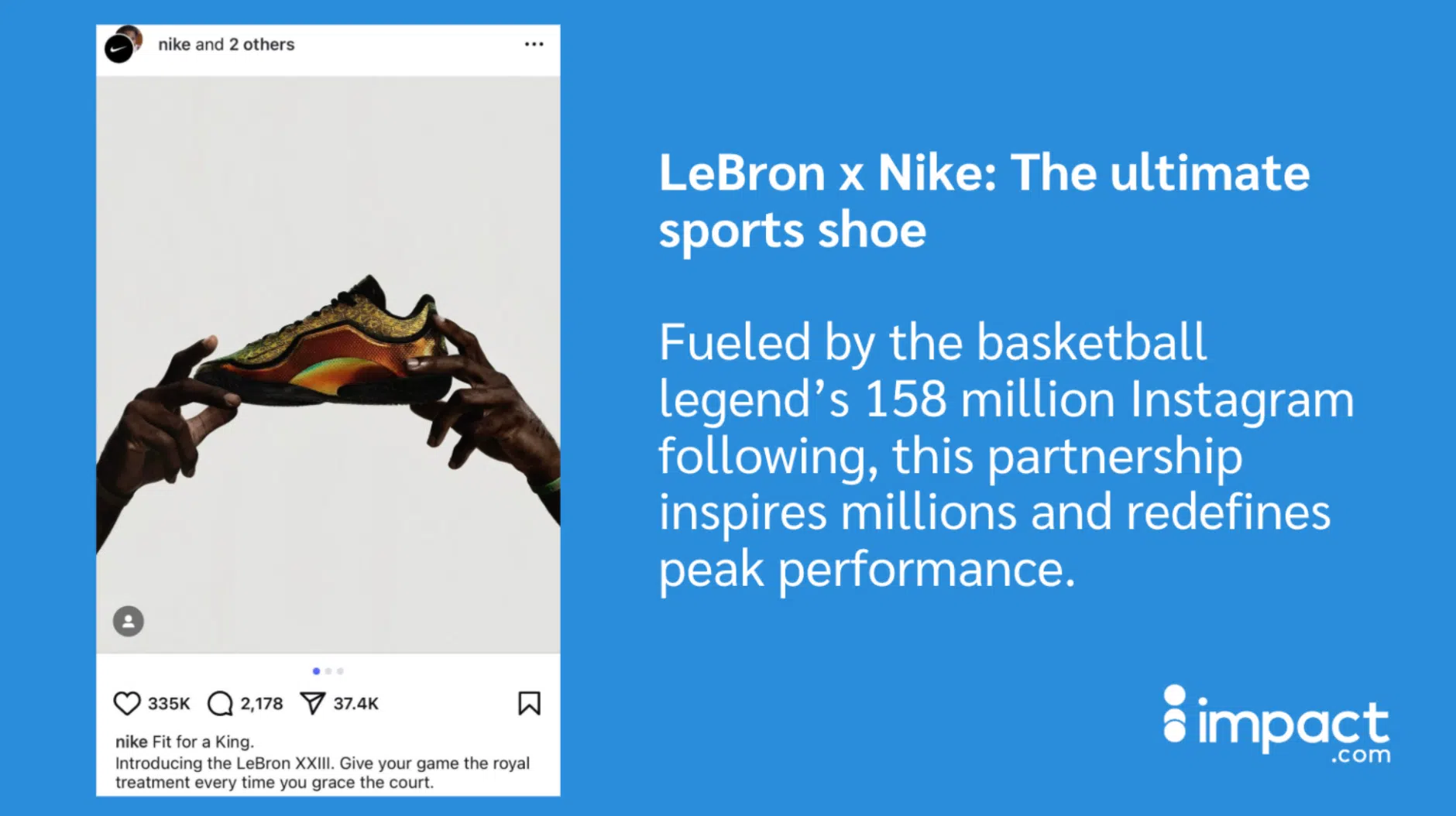
Macro-influencers: The lifestyle amplifiers
- Who they are: Popular fitness content creators (such as @kirstygodso), major regional lifestyle bloggers, or well-known trainers (e.g., popular running coaches, high-profile yogis).
- Primary goal: Broad product promotion and trend-setting, balancing massive reach with relevant content.
- Channels: Instagram Reels (for aesthetic visuals), YouTube videos (for workout routines), and sponsored events.
- What they accomplished: These creators integrate Nike products into high-quality, aspirational daily life content, reaching hundreds of thousands of active consumers and driving traffic to product launch pages.
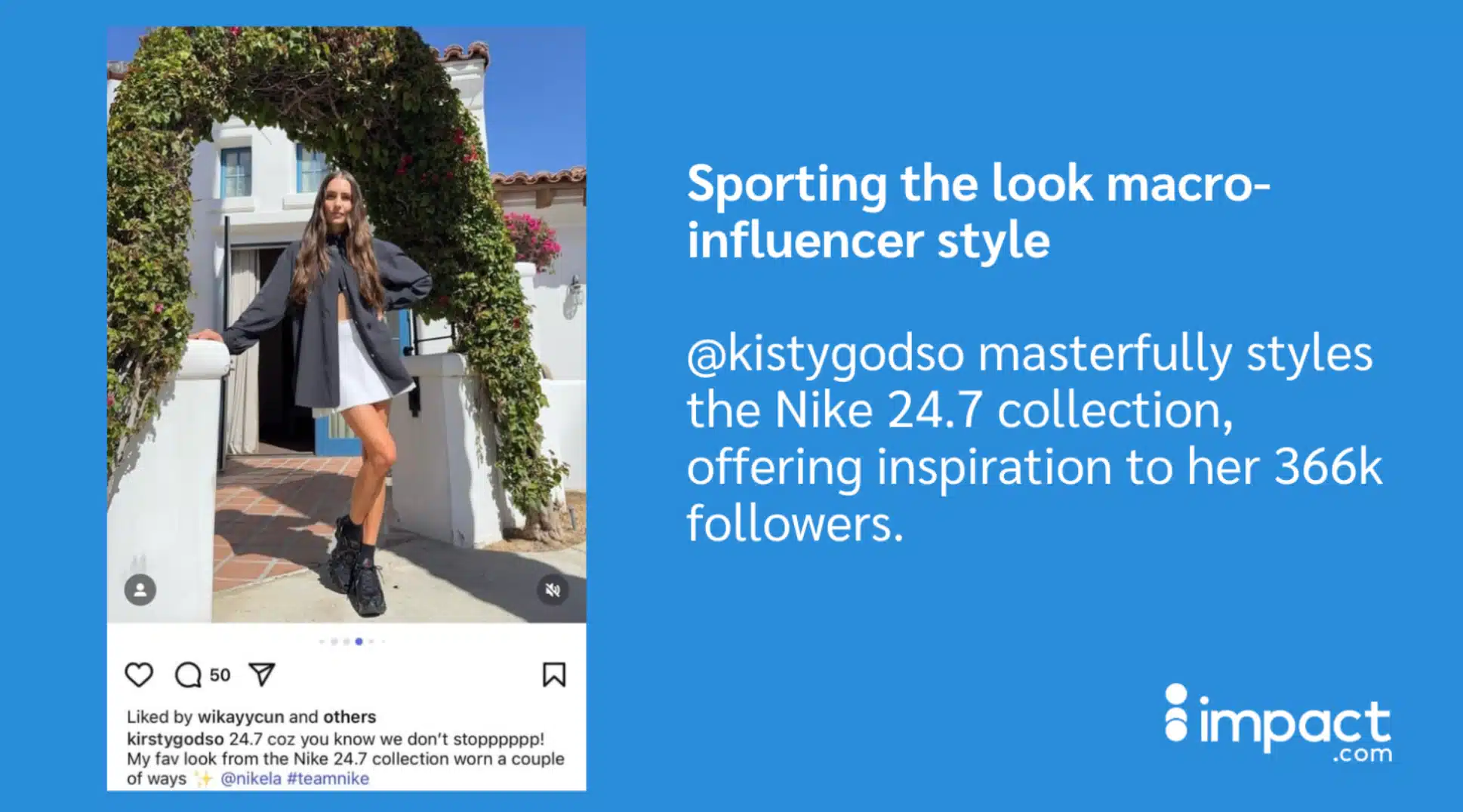
Nano- and micro-influencers: The authenticity core
- Who they are: Local running club leaders (@fitfreiburgs), niche sports gear reviewers, specialized fitness experts, or everyday loyal fans.
- Primary goal: Drive conversions, generate authentic product reviews, and build trust within highly specific, engaged niches.
- Channels: Instagram posts/Stories (for honest reviews), TikTok (for challenges), and localized community programs.
- What they accomplished: Their authentic content acts as social proof, convincing skeptical niche audiences to convert. This consistent, hyper-relatable content creates a continuous, high-ROI stream UGC.
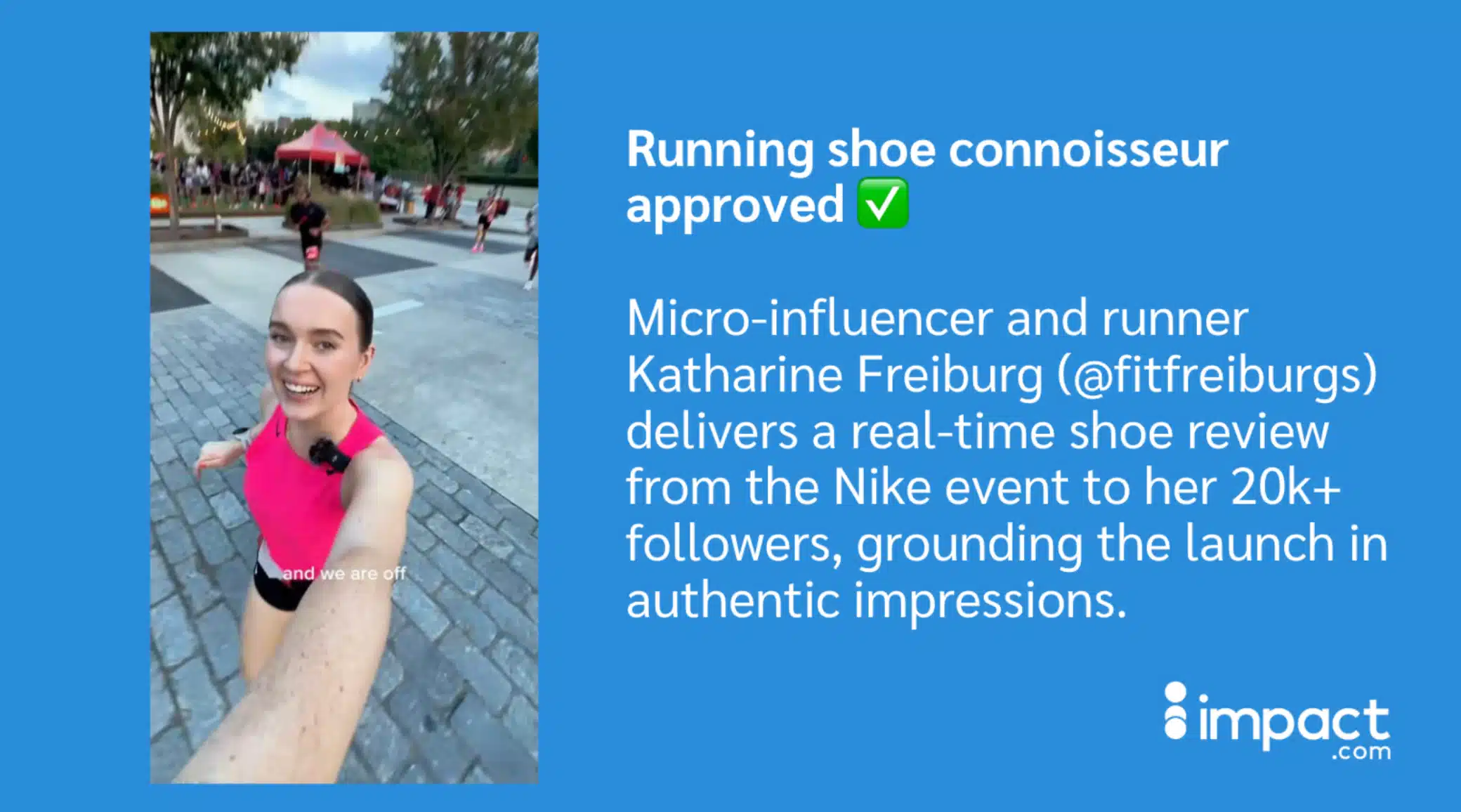
The full-funnel advantage for Nike and consumers
Nike’s influencer portfolio isn’t just success because of who the team chose. It’s about how these tiers work together to guide the consumer along the purchasing journey.
For Nike
The portfolio ensures maximum efficiency:
- Top of funnel: The expensive celebrity tier wins awareness and prestige.
- Middle and bottom of the funnel: The cost-effective micro-influencer tier wins in education, authenticity, and driving conversions.
This balanced approach creates a predictable growth engine, sustaining brand momentum without relying solely on high-cost endorsements.
For the consumer
The consumer has a seamless, holistic experience:
- Aspiration: Celebrities and elite athletes inspire their lifestyles and goals.
- Relevance: Macro-influencers integrate the product into engaging content such as workouts.
- Trust and conversion: Niche experts provide authentic product reviews, highlighting the major selling points.
- Result: Stronger customer loyalty and LTV.
How to scale your influencer portfolio
You don’t have to double your workload or budget to scale. Start small and optimize as you go.
Here’s a quick checklist to guide your growth:
- Launch a low-risk pilot program: Test partnerships with a handful of creators before investing heavily.
- Implement tiered incentive structures: Reward creators based on performance to keep costs efficient.
- Build long-term relationships: Consistency leads to trust, loyalty, and more authentic content.
- Use technology: Use platforms to streamline discovery, contracting, and performance tracking.
- Repurpose UGC: Extend the value of influencer content by sharing it across your own channels.
- Create a brand ambassador program: Formalize long-term partnerships to sustain growth.
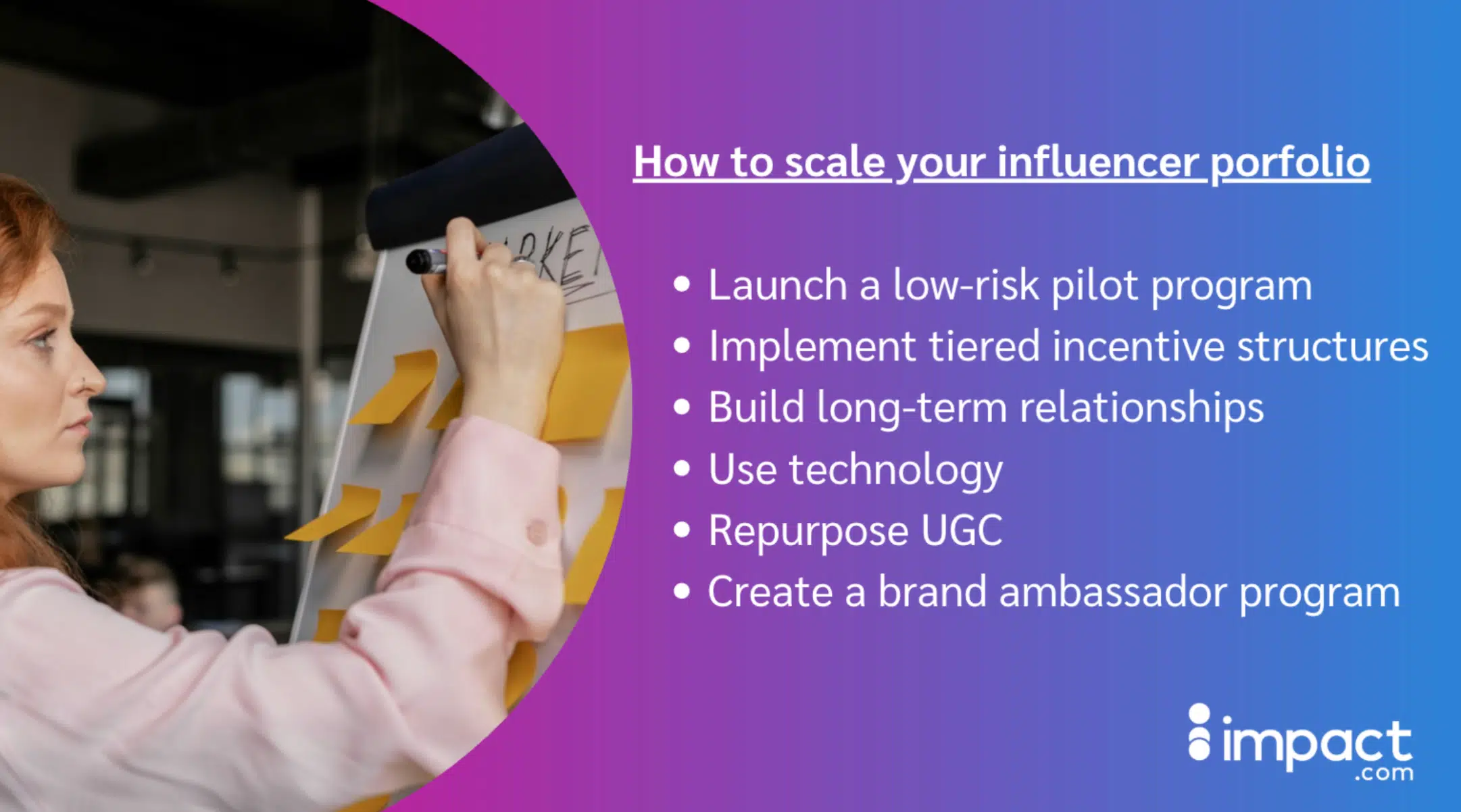
1. Launch a low-risk pilot program
Before scaling, you need a solid foundation.
Influencer marketing is a long game that requires trial and error, constant tweaking, and ongoing performance reviews, adds Savage.
The best place to start is with a small group of three to five creators across tiers. Test different content formats, messaging angles, and campaign goals.
Review the results:
- Which posts resonated most?
- What drove conversions?
- What fell flat?
Key takeaway: The lessons you learn from a low-risk pilot program give you clarity to double down on what works, and the confidence to scale smarter, not riskier.
2. Implement tiered incentive structures
One of the best ways to scale your program is by tying creator compensation directly to performance. Instead of relying on a flat fee, use a hybrid model that combines a base payment with commission or bonuses.
This approach ensures creators are fairly paid for their time while motivating them to deliver stronger results. Savage notes that tiered incentives are a best practice for encouraging better performance.
Here’s how it works in practice:
- Base payment: Covers the creator’s effort and content production.
- Performance bonus: Rewards them for hitting specific milestones, like conversions or revenue goals.
For example, you could tell creators, “If you drive ten conversions or generate $1,000 in revenue, we’ll add a $100 bonus.”
Clear, achievable targets make expectations transparent and inspire creators to go the extra mile.
Key takeaway: Tiered incentive structures are a win-win: your brand gets more value from its budget, and creators unlock greater earning potential.
3. Build long-term relationships
The foundation of a scalable influencer program isn’t one-off deals, it’s long-term partnerships.
Nurturing these connections saves money by eliminating the need to constantly search for new partners. It also leads to more authentic and consistent content.
When you invest in creators early, you’re betting on their growth. If they gain traction and expand their audience, your brand benefits from increased reach and stronger returns without the added cost of starting fresh.
To foster these relationships:
- Offer creative freedom: Use flexible briefs that provide key messaging but let creators deliver it in their own style.
- Check in regularly: Keep communication open so influencers feel like true partners, not contractors.
- Reward loyalty: Consider ambassadorships or affiliate models that incentivize ongoing collaboration.
Key takeaway: Long-term partnerships transform creators into brand supporters, simplifying your program and making it more cost-effective to scale.
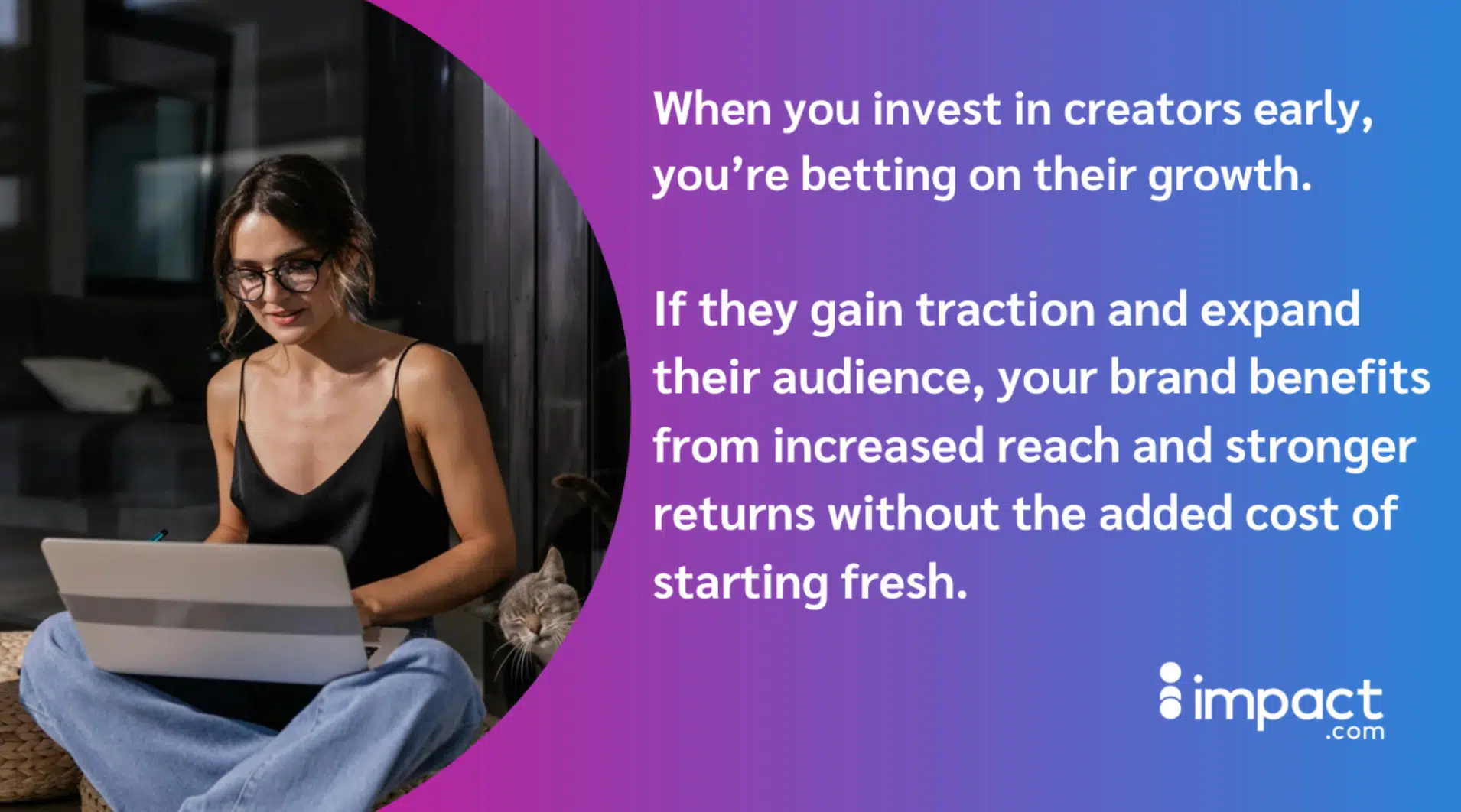
4. Use technology for ongoing recruitment and management
Manual discovery has its place, as discovery can come from anywhere. But scrolling hashtags and searching profiles doesn’t scale. To grow efficiently, you need technology to take on the heavy lifting.
Partnership platforms like impact.com and cutting-edge Social Listening tools can:
- Automate discovery: Quickly surface creators already talking about your brand or niche.
- Vet at scale: Filter by audience demographics, engagement rates, and content quality in minutes, not days.
- Centralize management: Handle contracts, payments, and reporting from one platform.
- Offer AI-powered tools: Features like ask impact’s AI chatbot pull up instant responses to questions like “Who were my top performing micro-influencers in the last six months?”
Key takeaway: Let technology power efficiency, but keep the relationship-building personal. Authentic partnerships still require a human touch.
5. Repurpose UGC
One of the biggest advantages of working with content creators is the authentic, high-quality content they create. This UGC resonates with their audiences and becomes a powerful brand asset.
Include content rights in your partnership agreements so you can repurpose UGC across your own channels:
- Social media posts
- Email campaigns
- Product pages or landing pages
Key takeaway: Repurposed UGC acts as built-in social proof, showing real people enjoying your products. It also saves you money on professional photoshoots and in-house content creation, making your influencer program cost-effective.
6. Create a brand ambassador program
Once you’ve identified your partners, formalize those partnerships into a brand ambassador program.
This turns one-off wins into an ongoing system of collaboration and advocacy.
An ambassador program can include:
- Exclusive benefits: Give ambassadors early access to products, insider updates, or special perks.
- Tiered commissions: Reward performance by increasing commission rates or offering bonuses as they hit higher sales or engagement goals.
- Content support: Provide free products, credits, or creative resources to encourage consistent content creation.
Key takeaway: Ambassador programs are a loyal community of advocates who know your brand, believe in it, and share it authentically with their audiences, driving long-term impact at scale.
FAQs
The influencer portfolio approach maximizes ROI by aligning creator size directly with your campaign objectives. At the top of the funnel, celebrity and macro-influencers are recruited for mass awareness and aspirational brand positioning. Conversely, micro-influencers drive authentic trust and conversion optimization at the middle and bottom of the funnel, providing a higher ROI per engagement. This strategic balancing act ensures you pay for reach when you need it and pay for sales when you need them.
Allocate budget based on your campaign’s primary goal. Micro-influencers offer superior cost-effectiveness for conversions. Use celebrity and macro-influencers to cover major initiatives like product launches or mass awareness. Dedicate a larger volume of budget to micro-influencers for conversion optimization and to generate high volumes of authentic UGC. Finally, implement a paid boost strategy, allocating 10-20 percent of your budget to amplify the top-performing micro-content for targeted reach.
The Authenticity Equation is a framework for vetting creator potential beyond simple follower count: Authenticity = (Relatability + Engagement + Niche Expertise) X Affinity. Use this formula to measure whether a creator truly aligns with your brand’s values, not just their audience size. The equation is multiplicative; if Affinity (A) is low—meaning the creator has no genuine connection to your brand—the entire result will be low, indicating low trust and minimal conversion power. Focus on finding creators who were posting about your topic long before sponsorships were on the table.
Protect your budget by reviewing profiles for clear red flags that indicate inauthentic accounts or purchased engagement. Watch for an unusual follower-to-following ratio and unexplained, sudden follower spikes (more than 20% growth in 30 days). Critically, analyze comment quality; generic responses or emojis are often signs of fake engagement, while real influence involves thoughtful questions and conversations. Also, engagement rates under two percent for smaller creators often suggest an inactive or inflated audience.
Transitioning from transactional one-off deals to long-term partnerships is the most effective way to drive customer LTV. First, reward loyalty by implementing tiered incentive structures like performance bonuses or commission rates, which encourage better results over time. Second, establish a “Trust contract” by providing creative freedom and checking in regularly, which transforms creators into authentic brand advocates. These loyal advocates are proven to deliver higher-quality customers than those acquired through single campaigns.
Mastering the influencer marketing portfolio for ROI
The future of influencer marketing rests on strategic deployment, not singular reliance on any one creator size. A truly high-performing program in 2025 uses a diverse portfolio to cover the entire consumer journey, leveraging the unique strengths of every tier to achieve specific campaign objectives.
This balanced approach ensures maximum ROI by assigning distinct functions.
- Celebrity/mega-influencers: Mass awareness, global reach, prestige.
- Micro/nano-creators: Authenticity, conversion, high brand trust, strong community, higher conversion rates.
First vet potential partners using the authenticity equation to ensure brand resonance. This will lead to higher conversions and predictable growth.
Next, use this roadmap to build and scale your program:
- Launch a low-risk pilot program to test what works.
- Invest budget into paid amplification for top-performing creator content.
- Build a brand ambassador program to nurture long-term relationships.
- Repurpose UGC to extend the value of influencer content across your channels.
Focusing on authentic creators, scalable processes, and sustainable partnerships will transform influencer marketing from a cost center into a predictable growth engine.
Ready to build your best micro-influencer campaign yet? Request a demo with impact.com.
Check out more content here:
- The marketer’s guide to AI-powered creator campaigns: A technology-agnostic framework [blog]
- Partnership Economy Podcast: Building brand equity through authentic community
- Discover the right creators to grow your brand [one sheet]
- Evaluating influencer performance in 2025: 3 ways brands can optimize ROI through real-time tracking [blog]
- Why 88% of Brands Are Failing Customers (and how AI is making it worse) [keynote]
- The ROI of long-term creator partnerships vs one-off campaigns [blog]










